|
Grilling | Grilling Method & Time
Grilling Ham Slices | Grilling Whole Ham | Tips
Grilling is a dry heat cooking method that quickly cooks the surface and then slowly moves to the middle. When grilled properly, the meat will have a crisp flavorful outside coating with a moist center. Grilling is generally done outdoors with the heat applied on the bottom surface of the meat. Grilling infuses the meat with a smoky flavor from the juices dripping on the charcoals. There are two basic types of grilling that are used, indirect grilling and direct grilling.
Grilling is ideal for cooking smaller ham cuts, such as ham slices, using the direct grilling method. It is not the best-suited method for cooking a whole or half ham. Because direct grilling uses high heat and short cooking times, a whole or half ham will become overcooked on the outside before the inside reaches the proper temperature. Indirect grilling is more suited for cooking whole or half hams.
Grilling
Indirect Heat | Direct Heat
The grilling process cooks foods over a high heat source, either directly, indirectly, or a combination of both. Grilling temperatures typically reach as high as 650ºF, but any temperature above 300°F is suitable as a grilling temperature. The high heat of grilling sears the surface of ham, creating meat with a flavorful crust. The required cooking temperature and the method of grilling (direct, indirect, or a combination) depends on the cut of ham and whether it is a fully cooked, partially cook, or uncooked.
There are many different types of grills available today that can be used when grilling ham. For information on the different types of grills, see Grill Types. It is important that the grill is set up properly and reaches the appropriate temperature for the cut of ham that is being grilled to ensure that it produces in a juicy, tender finished product that is cooked to the proper doneness. For information on setting up a charcoal or gas grill, see Outdoor Grill Preparation.
When grilling, ham should be cooked at a medium heat. To check the temperature of the grill, you can use the method of placing the palm of your hand at the cooking level above the heat source and the amount of time you can hold it there will indicate the heat level. For information on checking the temperature of the grill using the palm of your hand method, see Outdoor Grill Preparation. The thicker the cut the farther away from the heat source it should be or the heat source should be at a lower temperature to prevent the outside of the ham from burning before the inside is properly cooked. You will also have to decide whether you will use direct or indirect heat during the grilling time. Depending on the cut, you may use both. A cut, such as a whole or a half ham, may require direct heat to seal the outside and indirect to allow the cut to cook thoroughly to the center. See below for more information on indirect and direct heat grilling.
Indirect Heat Grilling
Indirect heat grilling is a method of grilling where you use an area of the grill that is not directly over the heat source. Using indirect heat slows the cooking process down, which allows the center of the cut to cook thoroughly without burning the outer surface. Coals are pushed to one side of the grill or banked into a ring around the outer edges to provide an area of indirect heat. On gas grills, the side of the burner, which is below the area where the food will be, is turned off after the grill is preheated. This will provide an area on the grill that will be a low heat source. The meat is placed over the area in which there are no coals or over the burner that is turned off on a gas grill. The ham is generally cooked with the grill hood closed. Indirect heat would be used for cooking larger cuts of meat, such as whole and half hams.
|
Indirect Heat Grilling on Charcoal Grills
Once the ham is prepared and the charcoals have been heated properly (see Charcoal Grill Setup), there are several easy steps to follow in order to cook ham with indirect heat on a charcoal grill. |
- There are different setups that can be used for indirect grilling on the charcoal grill. The coals can be pushed to one side of the grill and a pan placed on the opposite side. The pan is used to catch the fat as it melts and drips from the meat while cooking. This will help reduce flare-ups.
|
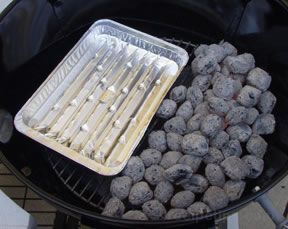
|
- An alternative method for arranging coals for indirect heat grilling is to place half the coals on one side of the grill and the other half on the opposite side. Some charcoal grills are equipped with side baskets, which can be used for this purpose. A drip pan is placed between the coals in the location where the meat will be cooked.
|
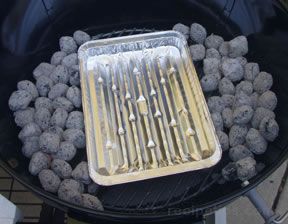
|
- A third method of arranging the coals is to bank them into a ring around the outer edges. Again, a drip pan is placed in the middle of the coals and when the grate is placed on the grill, this is the area the meat will be placed on the grate.
- When using any of the indirect methods, the ham is generally cooked with the cover on the grill.
|

|
- Any of the indirect charcoal grill setups provide an area on the grill, directly above the drip pan and away from the coals, that creates the indirect heat area.
|
|
Indirect Heat Grilling on Gas Grills
Once the ham is prepared and the gas grill have been heated properly (see Gas Grill Setup), there are several easy steps to follow in order to cook ham using indirect heat on a gas grill. |
- All of the burners, except one, are turned off. For the three burner grill pictured at right, the center and rear burners are turned off and the front burner remains on (high heat).
|
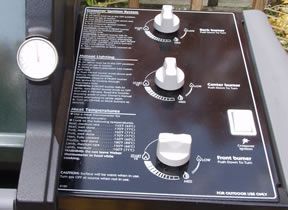
|
- A drip pan is placed on the opposite side away from the direct heat of the front gas burner. The ham is placed over the drip pan while cooking.
|
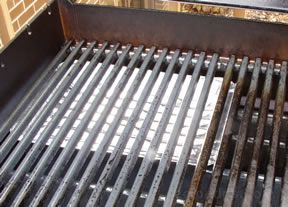
|
- The hood of the grill should be closed while allowing the ham to cook using the indirect heat of the grill.
|
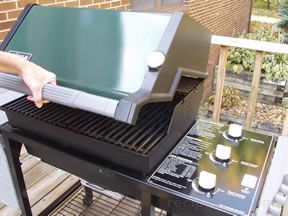
|
- Cook until internal temperature reaches the proper temperature. The proper doneness for fully cooked ham is 130° to 140°F and for hams that are not fully cooked it is 160° F. Remove the ham when the internal temperature is 5° below the desired temperature. Then allow it to stand for 15 minutes before carving or serving. During this time the temperature should rise another 5° to 10°F, which will bring the ham to its proper doneness.
|
Direct Heat Grilling
Direct heat grilling is a method of grilling where you cook the meat directly over the heat source. The meat is cooked quickly over medium coals and should be watched carefully to prevent overcooking. The meat cooked using direct heat can be cooked with the hood up but is generally cooked with the hood down. The ham is generally turned once during the cooking process. Direct heat is good for cooking smaller cuts, such as ham slices.
The heat from direct heat grilling will cook the ham quickly and if the cuts are too thin, they will overcook, causing them to dry out. The ham must be watched carefully while grilling. Coating the ham slices with a little oil or marinating it before cooking will help keep it moist. It is important that the heat source be properly preheated so that it seals the juices into the meat quickly. The temperatures at which the ham is cooked and the distance it is from the heat source are both important in producing tender, juicy, properly done ham.
| Direct Heat Grilling on Charcoal Grills |
- When using direct heat on a charcoal grill, the coals are generally spread in an even layer on the bottom of the grill to provide a consistently hot, even temperature under the entire cooking surface. It is beneficial to leave a small area along the edge where there are no coals. This provides a section where food can be moved if a flare up occurs while the meat is being cooked.
|

|
- To help prevent the meat from sticking to the grate on which it will be placed, brush the grate with oil and preheat the grill before placing the ham on the grate. The grill should be heated to a medium heat (see Grill Temperatures).
|
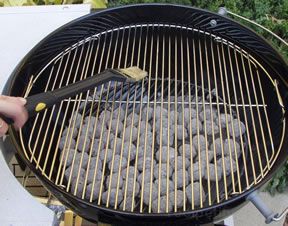
|
- The cooking temperature typically reaches 450ºF to 650ºF when grilling over direct heat. Thin cuts of meat are quickly grilled over such high temperatures, so check often and watch carefully for visual signs of doneness. It is generally suggested to turn the cuts only once.
|
Direct Heat Grilling on Gas Grills |
- When grilling ham with direct heat on a gas grill, all of the burners are turned on to provide a uniform temperature under the entire cooking surface (grate). Ham is cooked over burners set on medium heat.
|
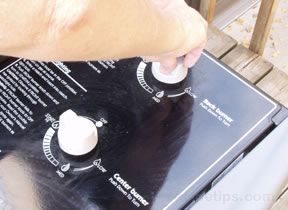
|
- While the grill is preheating, brush the surface of the ham with oil to help prevent them from sticking to the grate.
- It is also beneficial to brush oil on the grates before placing the food on them to help prevent sticking.
|

|
- Place the ham slices on the oiled grate once the grill has preheated to the proper temperature (see Grill Temperatures). Cook the ham in the same manner as shown above on the charcoal grill, using direct heat.
|
- The ham slices can be grilled with the cover up put they are generally cooked with the hood down and turned once during the cooking process.
|

|
- The cooking temperature typically reaches 450ºF to 650ºF when grilling over direct heat. Thin pieces of ham are quickly grilled over these temperatures, so check often and watch carefully for visual signs of doneness. It is generally suggested to turn the pieces only once. Use tongs or a spatula to turn the ham. A fork should not be used because it will pierce the meat, allowing juices to escape.
- Use the chart below for a quick reference for grilling methods and times when grilling ham.
|
| Type of Ham |
Grilling
Method |
Grilling Time |
Heat Level |
Ham Steak
1-inch,
pre-cooked |
Direct/Indirect |
Direct: 2-4 minutes each side
Indirect: 5-7 minutes each side |
Either Direct or Indirect can be used for pre-cooked ham steak. Direct is quicker but Indirect will give more of a grill taste. |
Ham,
pre-cooked, boneless, 1 lb. |
Indirect |
55-60 minutes |
 |
Ham,
whole w/bone
8-12 lbs. |
Indirect |
1¾-2¾ hours |
 |
Grilling Ham Slices
|
Ham slices that are going to be grilled should be a minimum of 1 inch thick and no thicker than 2 inches. Prepare and grill as indicated below. |
|
Prepare Ham Slices
- Trim the skin from the outer edge but leave a layer of fat.
- To keep ham slices flat while grilling, clip fat around the edges at 1 to 1 ½ inch intervals.
- Allow the ham to stand at room temperature for approximately 30 minutes before placing on the grill.
|
|
Grilling Ham Slices
- Preheat the grill to medium heat.
- To help prevent the ham slices from sticking to the grate on which they will be placed, the grate can be brushed with oil and the grill should be properly preheated before placing the meat on the grate.
- Place the ham slices on the grill approximately 4 inches above direct heat.
- Leaving the hood open, cook for 6 to 10 minutes on both sides or until each side is nicely browned.
- Remove from the grill and serve.
|
| Note: It is generally suggested to turn the cuts only once. Also, do not overcrowd the pieces so that if there are flare-ups from the drippings there is room to move pieces out of the way of the flames. |
Grilling Whole Ham
|
When purchasing a ham, take into consideration that a whole or half, fully cooked ham will be cooked in less time than a partially cooked or an uncooked ham. |
|
Prepare Ham and Glaze
- Score the surface of the ham by cutting about 1/4 inch deep lines 1/2 inch apart over the entire ham. Then do the same again but cut the lines in the opposite direction of the first set of lines, forming diamond shapes in the ham. Form more information on scoring the ham, see Ham Preparation - Scoring.
- Prepare your favorite glaze or use the one below (the glaze can be made while the ham is cooking on the grill). Bringing the following ingredients to a boil and cooking for one minute.
- 1 cup honey
- 1/3 cup butter
- 3 tbsp. dark corn syrup
- 3/4 tsp. dry mustard
- 2 tbsp. orange juice
- 2 tbsp. whole cloves
- Set glaze aside to use during the last 30 minutes of grilling time.
|
|
Grilling Ham
- Preheat the grill to medium-high heat.
- Prepare the grill for indirect heat grilling. See above.
- Place the ham in the area where the drip pan is located where there is no heat source. Instead of using a drip pan, the ham could be place in a foil pan and then placed on the grill with the heat source turned off directly under it.
- Close the hood while cooking the ham. Use estimated time from the cooking instructions on the package. Start checking for doneness 30 to 40 minutes before the end of the estimated cooking time.
- When the ham is 15° to 20°F below the proper doneness temperature, begin to coat the ham with the glaze. Glaze it approximately every 10 minutes until it is 5°F below the proper doneness temperature.
- Remove from the grill, tent with foil, and allow to stand for 15 minutes before carving and serving.
|
| Note: Grilling whole or half hams is not always recommended because of their size and density. Some people feel that grilling does not necessarily enhance the flavor of the ham because of the smoked or curing process it has gone through. If you enjoy grilling, it is worth a try to taste for yourself whether or not it is worth it. |
For more information on ham, see Meat - Ham.
Grilling Tips
- When grilling ham slices or steaks, preheat the grill to proper temperature to ensure the meats surface is seared quickly to seal in juices.
- Using clean racks and coating them with vegetable oil or a nonstick vegetable oil spray will help prevent the meat from sticking.
- To keep ham slices flat while grilling, clip fat around the edges at 1 to 1 ½ inch intervals.
- Do not use a fork to turn the ham as it cooks. The piercing causes juices to escape. Use tongs to turn.
|










